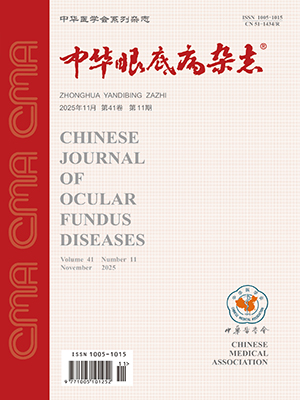| 1. |
Jaulim A, Ahmed B, Khanam T, et al. Branch retinal vein occlusion: epidemiology, pathogenesis, risk factors, clinical features, diagnosis, and complications. An update of the literature[J]. Retina, 2013, 33(5): 901-910. DOI: 10.1097/IAE.0b013e3182870c15.
|
| 2. |
Hayreh SS. Photocoagulation for retinal vein occlusion[J/OL]. Prog Retin Eye Res, 2021, 85: 100964[2021-03-11]. https://linkinghub.elsevier.com/retrieve/pii/S1350-9462(21)00025-2. DOI: 10.1016/j.preteyeres.2021.100964.
|
| 3. |
Song P, Xu Y, Zha M, et al. Global epidemiology of retinal vein occlusion: a systematic review and meta-analysis of prevalence, incidence, and risk factors[J/OL]. J Glob Health, 2019, 9(1): 010427[2019-06-01]. https://europepmc.org/article/MED/31131101. DOI: 10.7189/jogh.09.010427.
|
| 4. |
Mingji C, Onakpoya IJ, Perera R, et al. Relationship between altitude and the prevalence of hypertension in Tibet: a systematic review[J]. Heart, 2015, 101(13): 1054-1060. DOI: 10.1136/heartjnl-2014-307158.
|
| 5. |
Yang JY, You B, Wang Q, et al. Retinal vessel oxygen saturation in healthy subjects and early branch retinal vein occlusion[J]. Int J Ophthalmol, 2017, 10(2): 267-270. DOI: 10.18240/ijo.2017.02.14.
|
| 6. |
Mlinar T, Debevec T, Kapus J, et al. Retinal blood vessel diameters in children and adults exposed to a simulated altitude of 3, 000 m[J/OL]. Front Physiol, 2023, 14: 1026987[2023-02-28]. https://europepmc.org/article/MED/36926190. DOI:10.3389/fphys.2023.1026987.
|
| 7. |
Li Q, Guo Z, Liu F, et al. The effects of altitude-related hypoxia exposure on the multiscale dynamics of blood pressure fluctuation during sleep: the observation from a pilot study[J]. Nat Sci Sleep, 2021, 13: 1147-1155. DOI: 10.2147/NSS.S319031.
|
| 8. |
Baker J, Safarzadeh MA, Incognito AV, et al. Functional optical coherence tomography at altitude: retinal microvascular perfusion and retinal thickness at 3, 800 meters[J]. J Appl Physiol (1985), 2022, 133(3): 534-545. DOI: 10.1152/japplphysiol.00132.2022.
|
| 9. |
Abdel-Qadir H, Ethier JL, Lee DS, et al. Cardiovascular toxicity of angiogenesis inhibitors in treatment of malignancy: a systematic review and meta-analysis[J]. Cancer Treat Rev, 2017, 53: 120-127. DOI: 10.1016/j.ctrv.2016.12.002.
|
| 10. |
Mirrakhimov AE, Strohl KP. High-altitude pulmonary hypertension: an update on disease pathogenesis and management[J]. Open Cardiovasc Med J, 2016, 10: 19-27. DOI: 10.2174/1874192401610010019.
|
| 11. |
Algahtani FH, AlQahtany FS, Al-Shehri A, et al. Features and incidence of thromboembolic disease: a comparative study between high and low altitude dwellers in Saudi Arabia[J]. Saudi J Biol Sci, 2020, 27(6): 1632-1636. DOI: 10.1016/j.sjbs.2020.03.004.
|
| 12. |
Baertschi M, Dayhaw-Barker P, Flammer J. The effect of hypoxia on intra-ocular, mean arterial, retinal venous and ocular perfusion pressures[J]. Clin Hemorheol Microcirc, 2016, 63(3): 293-303. DOI: 10.3233/CH-152025.
|
| 13. |
吴鹏程, 张文芳, 律鹏, 等. 青海省玛沁县40岁以上世居藏族人群视网膜血管性疾病相关因素的流行病学调查[J]. 国际眼科杂志, 2014(7): 1288-1291. DOI: 10.3980/j.issn.1672-5123.2014.07.32.Wu PC, Zhang WF, Lyu P, et al. Epidemical survey of relative factors of retinal vessels disease of the native Tibetan among the people aged 40 and above in Maqin county, Qinghai province[J]. Int Eye Sci, 2014(7): 1288-1291. DOI: 10.3980/j.issn.1672-5123.2014.07.32.
|
| 14. |
Gupta A, Singh S, Ahluwalia TS, et al. Retinal vein occlusion in high altitude[J]. High Alt Med Biol, 2011, 12(4): 393-397. DOI: 10.1089/ham.2010.1093.
|
| 15. |
Meier D, Collet TH, Locatelli I, et al. Does This patient have acute mountain sickness?: The rational clinical examination systematic review[J]. JAMA, 2017, 318(18): 1810-1819. DOI: 10.1001/jama.2017.16192.
|
| 16. |
Jonas JB, Mones J, Glacet-Bernard A, et al. Retinal vein occlusions[J]. Dev Ophthalmol, 2017, 58: 139-167. DOI: 10.1159/000455278.
|
| 17. |
Campochiaro PA, Heier JS, Feiner L, et al. Ranibizumab for macular edema following branch retinal vein occlusion: six-month primary end point results of a phase Ⅲ study[J]. Ophthalmology, 2010, 117(6): 1102-1112. DOI: 10.1016/j.ophtha.2010.02.021.
|
| 18. |
Thomley ME, Gross CN, Preda-Naumescu A, et al. Real-world outcomes in patients with branch retinal vein occlusion- (BRVO-) related macular edema treated with anti-vegf injections alone versus anti-VEGF injections combined with focal laser[J/OL]. J Ophthalmol, 2021, 2021: 6641008[2021-05-19]. https://europepmc.org/article/MED/34104482. DOI: 10.1155/2021/6641008.
|
| 19. |
Gale R, Pikoula M, Lee AY, et al. Real world evidence on 5661 patients treated for macular oedema secondary to branch retinal vein occlusion with intravitreal anti-vascular endothelial growth factor, intravitreal dexamethasone or macular laser[J]. Br J Ophthalmol, 2021, 105(4): 549-554. DOI: 10.1136/bjophthalmol-2020-315836.
|
| 20. |
Avery RL, Castellarin AA, Steinle NC, et al. Systemic pharmacokinetics and pharmacodynamics of intravitreal aflibercept, bevacizumab, and ranibizumab[J]. Retina, 2017, 37(10): 1847-1858. DOI: 10.1097/IAE.0000000000001493.
|
| 21. |
Billioti de Gage S, Bertrand M, Grimaldi S, et al. Risk of myocardial infarction, stroke, or death in new users of intravitreal aflibercept versus ranibizumab: a nationwide cohort study[J]. Ophthalmol Ther, 2022, 11(2): 587-602. DOI: 10.1007/s40123-021-00451-1.
|




